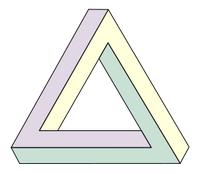Assessment |
Biopsychology |
Comparative |
Cognitive |
Developmental |
Language |
Individual differences |
Personality |
Philosophy |
Social |
Methods |
Statistics |
Clinical |
Educational |
Industrial |
Professional items |
World psychology |
Cognitive Psychology: Attention · Decision making · Learning · Judgement · Memory · Motivation · Perception · Reasoning · Thinking - Cognitive processes Cognition - Outline Index

The Penrose triangle

Impossible Triangle sculpture, East Perth, Australia
The Penrose triangle, also known as the tribar, is an impossible object. It was first created by the Swedish artist Oscar Reutersvärd in 1934. The mathematician Roger Penrose independently devised and popularised it in the 1950s, describing it as "impossibility in its purest form". It is featured prominently in the works of artist M.C. Escher, whose earlier depictions of impossible objects partly inspired it.
The tribar appears to be a solid object, made of three straight beams of square cross-section which meet pairwise at right angles at the vertices of the triangle they form.
This combination of properties cannot be realized by any 3-dimensional object. Nevertheless, there do exist 3-dimensional solid shapes each of which, when viewed from a certain angle, has the appearance of possessing all the qualities mentioned in the above paragraph. That is, it appears the same as the purple, green, and yellow 2-dimensional depiction of the Penrose triangle on this page.
M.C. Escher's lithograph Waterfall depicts a watercourse that flows in a zigzag along the long sides of two elongated Penrose triangles, so that it ends up two stories higher than it began. The resulting waterfall, forming the short sides of both triangles, drives a water wheel. Escher helpfully points out that in order to keep the wheel turning some water must occasionally be added to compensate for evaporation.
The concept can be extended to other polygons, making, for example the "Penrose square", but the visual effect is not as striking.
There exists some terminological confusion over whether "Penrose triangle" refers to the 2-dimensional depiction of an impossible 3-dimensional object, or that impossible object itself. (Philosophically, it is unclear what "that impossible object" refers to, other than a set of conditions that cannot be satisfied.)
If you trace a line around the Penrose triangle, you get a 3-loop Möbius strip.
Other Penrose polygons[]
While it is possible to construct a Penrose triangle with other regular polygons to create a Penrose polygon, the visual effect is not as striking, and as the sides increase, the image seems to be warped or twisted.
References[]
External links[]
bg:Триъгълник на Пенроуз
cs:Penroseův trojúhelník
de:Penrose-Dreieck
fr:Triangle de Penrose
ko:펜로즈 삼각형
lb:Penrose-Dräieck
nl:Penrose-driehoek
| This page uses Creative Commons Licensed content from Wikipedia (view authors). |



